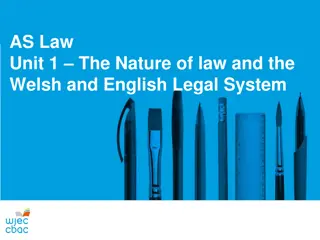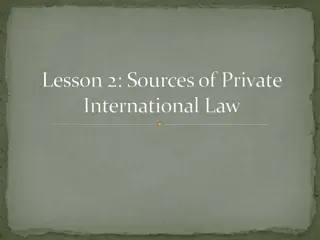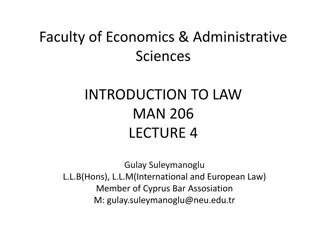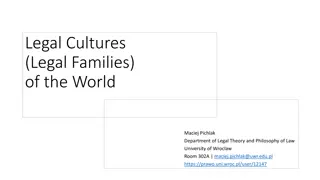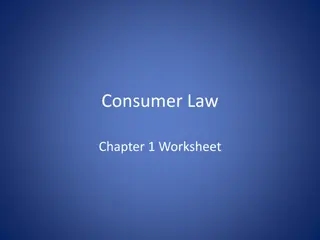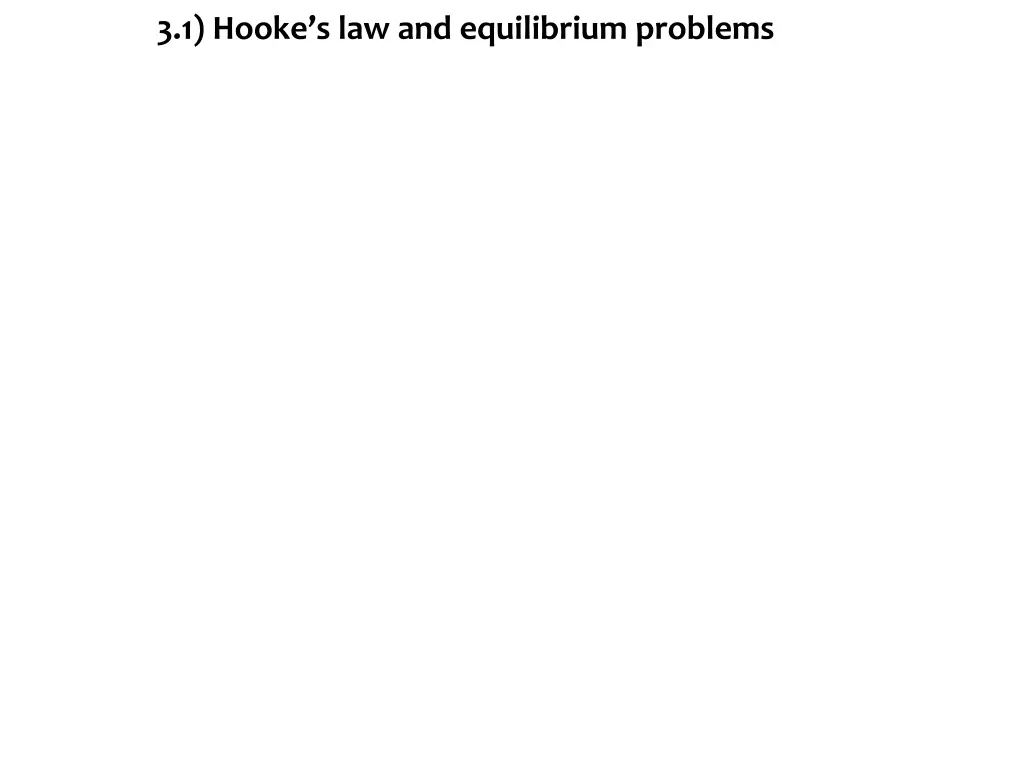
Solving Elasticity and Equilibrium Problems with Hooke's Law Examples
Explore practical examples involving Hooke's Law and equilibrium problems in physics. Learn how to find extensions, tensions, and modulus of elasticity for various scenarios with strings and springs.
Download Presentation

Please find below an Image/Link to download the presentation.
The content on the website is provided AS IS for your information and personal use only. It may not be sold, licensed, or shared on other websites without obtaining consent from the author. If you encounter any issues during the download, it is possible that the publisher has removed the file from their server.
You are allowed to download the files provided on this website for personal or commercial use, subject to the condition that they are used lawfully. All files are the property of their respective owners.
The content on the website is provided AS IS for your information and personal use only. It may not be sold, licensed, or shared on other websites without obtaining consent from the author.
E N D
Presentation Transcript
Your turn Worked example An elastic string of natural length 2m and modulus of elasticity 29.4N has one end fixed. A particle of mass 4kg is attached to the other end and hangs at rest. Find the extension of the string. An elastic string of natural length 4m and modulus of elasticity 58.8N has one end fixed. A particle of mass 2kg is attached to the other end and hangs at rest. Find the extension of the string. 2.67 ? (3 sf)
Your turn Worked example A string of natural length ? and modulus of elasticity 123N is stretched to a length 3?. What is the Tension in the string? A string of natural length ? and modulus of elasticity 123N is stretched to a length 2?. What is the Tension in the string? 246 ?
Your turn Worked example A string of natural length ? and modulus of elasticity 123N is extended by a distance 2?. What is the Tension in the string? A string of natural length ? and modulus of elasticity 123N is extended by a distance 3?. What is the Tension in the string? 246 ?
Your turn Worked example A spring of natural length 3m is stretched to a length of 6m by applying a force to both ends of 99N. What is the modulus of elasticity of the spring? A spring of natural length 3m is stretched to a length of 12m by applying a force to both ends of 99N. What is the modulus of elasticity of the spring? 99 ?
Your turn Worked example A spring of natural length ? and ? = 40? is compressed to a length 3 What is the compressive force? A spring of natural length ? and ? = 80? is compressed to a length 1 What is the compressive force? 4?. 4?. 10 ? A string of natural length ? and ? = 40? is compressed by a force of 10N. What is ?? Unknown strings collapse under compression
Your turn Worked example An elastic spring of natural length 1.5 ? has one end attached to a fixed point. A horizontal force of magnitude 6 ? is applied to the other end and compresses the spring to a length of 1 ?. Find the modulus of elasticity of the spring. An elastic spring of natural length 3 ? has one end attached to a fixed point. A horizontal force of magnitude 12 ? is applied to the other end and compresses the spring to a length of 2 ?. Find the modulus of elasticity of the spring. 18 ?
Your turn Worked example The elastic springs PQ and QR are joined together at Q to form one long spring. The spring PQ has natural length 1.6 m and modulus of elasticity 20 N. The spring QR has natural length 1.4 m and modulus of elasticity 28 N. The ends P and R, of the long string are attached to two fixed points which are 4 m apart on the same horizontal plane. [Assume Q is at rest and in equilibrium]. Find the Tension in the combined spring. The elastic springs PQ and QR are joined together at Q to form one long spring. The spring PQ has natural length 3.2 m and modulus of elasticity 40 N. The spring QR has natural length 2.8 m and modulus of elasticity 56 N. The ends P and R, of the long string are attached to two fixed points which are 8 m apart on the same horizontal plane. [Assume Q is at rest and in equilibrium]. Find the Tension in the combined spring. 7.69 ? (3 sf)
Your turn Worked example A particle of mass 5 ?? is attached to one end of two light elastic strings. The other ends of the strings are attached to a hook on the beam. The particle hangs in equilibrium at a distance 120 ?? below the hook with both strings vertical. One string has natural length 100 ?? and modulus of elasticity 175 ?. The other string has natural length 90 ?? and modulus of elasticity ? ?. Find the value of ?. A particle of mass 10 ?? is attached to one end of two light elastic strings. The other ends of the strings are attached to a hook on the beam. The particle hangs in equilibrium at a distance 240 ?? below the hook with both strings vertical. One string has natural length 200 ?? and modulus of elasticity 350 ?. The other string has natural length 180 ?? and modulus of elasticity ? ?. Find the value of ?. ? = 42
Your turn Worked example An elastic string of natural length 2? and modulus of elasticity 4?? is stretched between two points A and B. The points A and B are on the same horizontal level and AB =2?. A particle P is attached to the midpoint of the string and hangs in equilibrium with both parts of the string making an angle of 30 with the line AB. Find, in terms of ?, the mass of the particle. An elastic string of natural length 4? and modulus of elasticity 8?? is stretched between two points A and B. The points A and B are on the same horizontal level and AB =4?. A particle P is attached to the midpoint of the string and hangs in equilibrium with both parts of the string making an angle of 60 with the line AB. Find, in terms of ?, the mass of the particle. 0.619? kg (3 sf)
Your turn Worked example An elastic string has natural length 2 ? and modulus of elasticity 98 ?. One end of the string is attached to a fixed point O and the other end is attached to a particle P of mass 4 ??. The particle is held in equilibrium by a horizontal force of magnitude 28 ?, with OP making an angle ? with the vertical. Find: a) The value of ? b) The length OP An elastic string has natural length 4 ? and modulus of elasticity 196 ?. One end of the string is attached to a fixed point O and the other end is attached to a particle P of mass 8 ??. The particle is held in equilibrium by a horizontal force of magnitude 56 ?, with OP making an angle ? with the vertical. Find: a) The value of ? b) The length OP a) 35.5 (3 sf) b) 2.98 ? (3 sf)
Your turn Worked example Two identical springs PQ and QR each have natural length ? and modulus of elasticity 2??. The springs are joined together at Q. Their other ends, P rand R, are attached to fixed points with P being 4? vertically above R. A particle of mass ? is attached to Q and hangs at rest in equilibrium. Find the distance of the particle below P. Two identical springs PQ and QR each have natural length ? and modulus of elasticity 4??. The springs are joined together at Q. Their other ends, P rand R, are attached to fixed points with P being 8? vertically above R. A particle of mass ? is attached to Q and hangs at rest in equilibrium. Find the distance of the particle below P. 9? 4
Your turn Worked example One end, A, of a light elastic string AB, of natural length 0.6? and modulus of elasticity 10 ?, is fixed to a point on a fixed rough plane inclined at an angle ? to the horizontal where sin? =4 A ball of mass 3 ?? is attached to the end B of the string. The coefficient of friction, ?, between the ball and plane is 1 3. The ball rests in limiting equilibrium, on the point of sliding down the plane, with AB along the line of greatest slope. Find: a) The tension in the string b) The length of the string One end, A, of a light elastic string AB, of natural length 0.3? and modulus of elasticity 5 ?, is fixed to a point on a fixed rough plane inclined at an angle ? to the horizontal where sin? =3 A ball of mass 1.5 ?? is attached to the end B of the string. The coefficient of friction, ?, between the ball and plane is 1 4. The ball rests in limiting equilibrium, on the point of sliding down the plane, with AB along the line of greatest slope. Find: a) The tension in the string b) The length of the string 5. 5. a) 17.6 ? (3 sf) b) 1.66 ? (3 sf)
Your turn Worked example A particle P, of mass ?, rests in equilibrium on a rough plane inclined at 30 to the horizontal. The coefficient of friction A particle P, of mass ?, rests in equilibrium on a rough plane inclined at 60 to the horizontal. The coefficient of friction 3 3 between the particle and the plane is P is attached to a fixed point A on the plane by a light elastic spring with natural length ? and modulus of elasticity 3??. P is free to move only in a straight line below A down the line of greatest slope. Write an inequality for the length AP. 3. between the particle and the plane is P is attached to a fixed point A on the plane by a light elastic spring with natural length ? and modulus of elasticity 6??. P is free to move only in a straight line below A down the line of greatest slope. Write an inequality for the length AP. 3. ? ?? 4? 3





